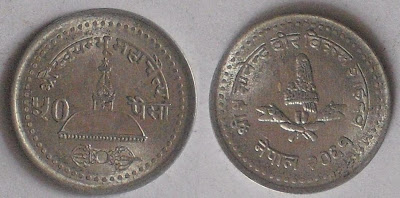Swayambhu Mahachaitya

50 paisa, 2004
 Weight: 1.41gm
Weight: 1.41gmMetal : Aluminium
Diameter: 22.5mm
Obverse: dome of swayambhu maha chaitya
Reverse: crown
Date: 2061 VS=2004AD
The lettering above the crown on obverse reads "shree swayambhu maha chaitya".Swayambhu is a pilgrimage centre in the Kathmandu valley revered by Hindus and Buddhists, by people of Nepal, India, Bhutan and china. From almost all parts of the Kathmandu valley, we can see beautiful views of the Swayambhu hill, which is also known as “Gopucchha” and ”Gosringa” hill because it looks like a tail or horn of a cow when one observes it from the Chobhar hill.
The site of Swayambhu mahachaitya is very beautiful where many old botanical species grow.
According to the legend, the Vipaswi Buddha came to a lake here and sowed a lotus seed here.From the flower that bloomed, swayambhujyoti(sele originated flame) is said to have emanated. On hearing about the flame, pilgrims started coming to the place. One of the pilgrims, Mahamanjushree cut out a slit at the hill at Chobar with the hel of his spouses Varada and Mokshyada, and dried out the lake to make it suitable for human settlement. At the site where the Swayambhu jyoti had emerged, a stupa was created which came to be known as the Swayambhu mahachaitya.
There is no proper archaeological evidence to support the legend, although geology does confirm that the valley originated from a lake. It can be assumed that after the lake dried up, human settlement began in the region about 1000 years ago, based on the stories in the puranas and the local chronicles.
The site of Swayambhu mahachaitya is very beautiful where many old botanical species grow.
According to the legend, the Vipaswi Buddha came to a lake here and sowed a lotus seed here.From the flower that bloomed, swayambhujyoti(sele originated flame) is said to have emanated. On hearing about the flame, pilgrims started coming to the place. One of the pilgrims, Mahamanjushree cut out a slit at the hill at Chobar with the hel of his spouses Varada and Mokshyada, and dried out the lake to make it suitable for human settlement. At the site where the Swayambhu jyoti had emerged, a stupa was created which came to be known as the Swayambhu mahachaitya.
There is no proper archaeological evidence to support the legend, although geology does confirm that the valley originated from a lake. It can be assumed that after the lake dried up, human settlement began in the region about 1000 years ago, based on the stories in the puranas and the local chronicles.




No comments:
Post a Comment